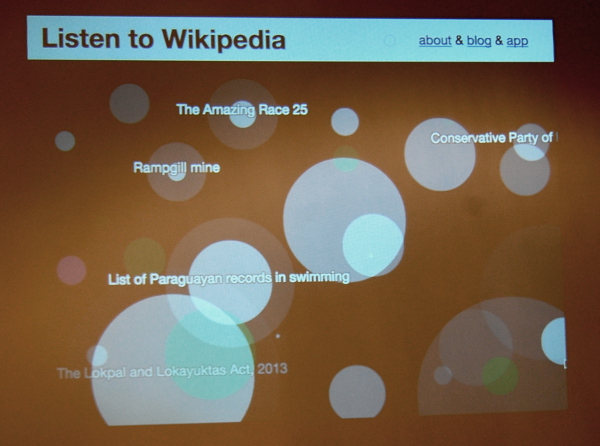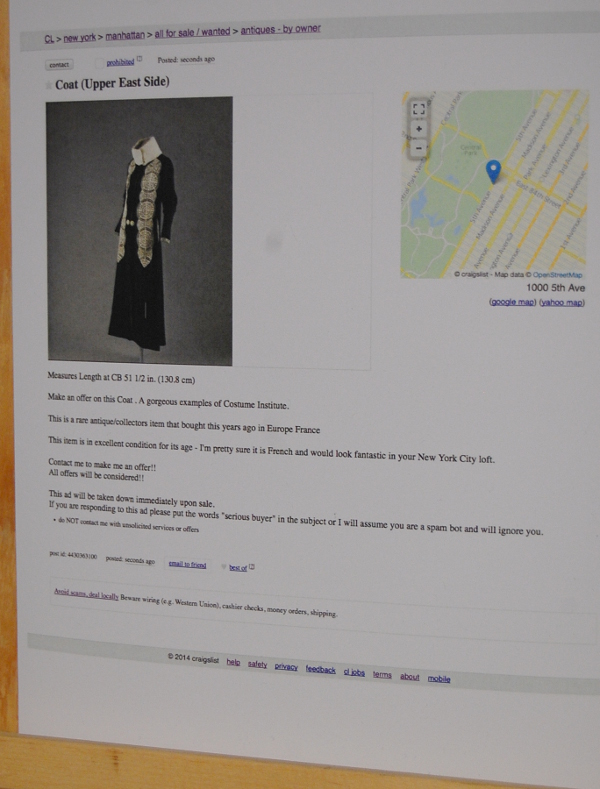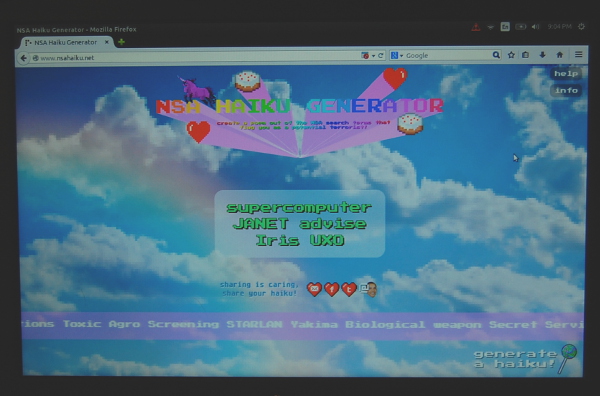
Generative art and the unconscious Internet at Little Berlin
Spending a ton of time in the studio? Ever wish your artwork could just make itself? Whether or not any of this applies, Little Berlin has a surprise for you this month with its show “Heavily Scripted: Generative Art And Bots” curated by Lee Tusman. Although the artworks here are not exactly self-made, they represent various forms of programmed creations that, once activated, run more or less on their own accord. And that is only where the madness begins, as ancient art collections are put up for ‘sale’ on Craigslist, Wikipedia sings us the song of its people, and the NSA is trolled yet again.
One of the easiest pieces to decipher – and perhaps the most noticeable work in the exhibit – is the audio/visual meditation “Listen To Wikipedia” by Stephen LaPorte and Mahmoud Hashemi. Here we find a giant projection that pairs sound with recent edits to Wikipedia pages. The screen is almost constantly in motion as circles of different colors expand from the titles of the edited entries: green for unregistered contributors and purple for edits performed by automated bots. As for the sounds themselves, bells indicate additions while strings are subtractions. Pitches also get deeper as the edits get larger, and string swells welcome new users when they join the site. Even without all of this in mind, the ripples of information updates and auditory accompaniment are rather hypnotizing on their own. Standing before the flood of information is flooring in its own right, and as the tones and shapes spread, we are submerged in data as wide-ranging as North Carolina Class Battleships, Banjos and Holy See-Saudi Arabia Relations. If you’ve ever gotten stuck in a late night Wikipedia loop, be forewarned that this mystical soothsayer is also a time-stealing trap.
Tega Brain’s “Post The Met” attempts to auction off an antique French coat on Craigslist.
The Metropolitan Museum of Art in New York City has one of the largest collections of works from classical antiquity, Ancient Egypt, and all across the globe. On The Met’s site, visitors can peruse many of the historically valuable works by way of a public web archive. Artist Tega Brain, on the other hand, had different plans for the collection. By creating software to randomly select entries from the archive, these antiquities were then posted along with automatically generated text to the antiques section of Craigslist. Each post requests that interested individuals make an offer on the item in question. The social experiment was eventually shut down by The Met, but not before it created a slew of hilariously hijacked advertisements for real artifacts. Poking fun at the museum’s no-nonsense posturing, the lavish lifestyles of New York City elites, and the very culture of Craigslist, “Post The Met” is a brilliantly subversive romp through the Internet’s back doors.
An inclusion by Google itself stands off rather humbly to the side of the fray. “Webdriver Torso” is the mysterious YouTube account that has posted red and blue rectangles with tones every few minutes since it was created. Since it was discovered, speculation about its creator and meaning erupted across the web and it acquired a certain infamy. Since then, Italian blogger Soggetto Ventuno solved the enigma by revealing it as a way for Internet behemoth Google to test upload speeds and quality. Even armed with this knowledge, the strange compositions are as intriguing as the artworks themselves, their purpose having stoked the imaginations of technologically inquisitive minds around the world. Functional aside, this ongoing parade of abstract images is as much a tool as an aesthetic anomaly; purposeful, generative videos turned accidental art.
Grayson Earle, “NSA Haiku Generator.”
No show of this nature would be complete without thumbing one’s nose at the data-crunching spy-fest that is the National Security Agency. Grayson Earle created “NSA Haiku Generator” to utilize the NSA’s database of terms that can turn unwitting citizens using electronic communications into potential targets. By taking this potentially serious incursion and turning it into a cat and mouse game, Earle allows users to generate haiku poems from the flagged terms, which can then be shared on social media. In this way, the NSA will find its efforts flooded by an outpouring of poetry in place of plotting.
At a time when so much of the data we consume depends on software and automatic systems in one way or another, what better way to understand and confront this inevitability than through our artistic expression? Tusman’s compilation of generative work in “Heavily Scripted” scratches the surface of the mad world of algorithms and advertisements that is always churning just below the realm of our immediate perception. The exhibit will be on display through October 25.
Little Berlin is located at 2430 Coral St., Philadelphia; [email protected]; littleberlin.org.
Recent Content
-
Artsarticle ·
-
Artsarticle ·
-
Artsarticle ·



